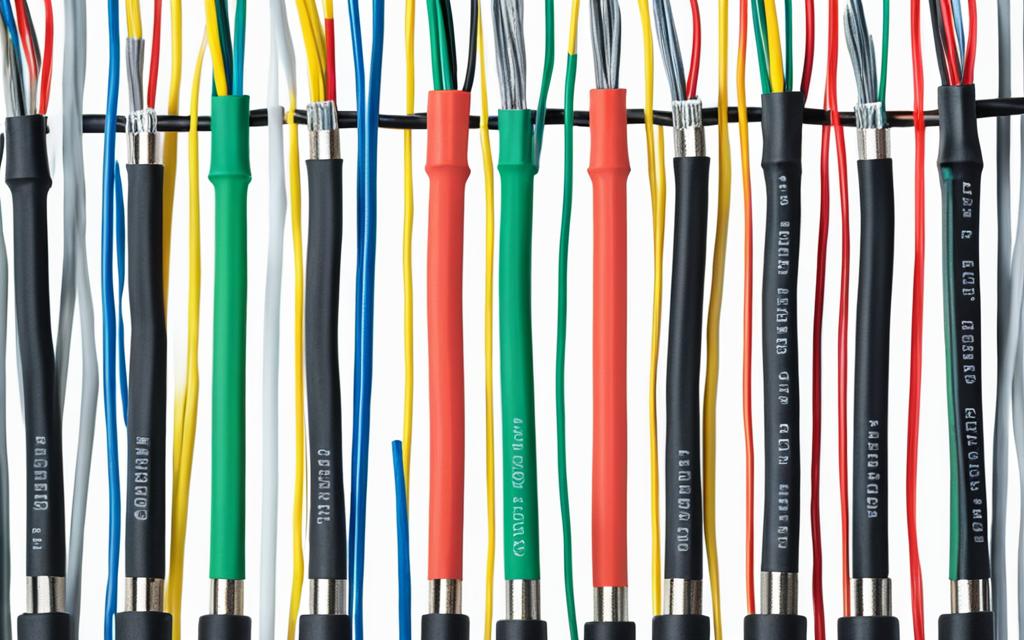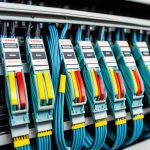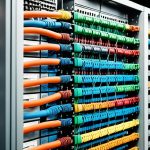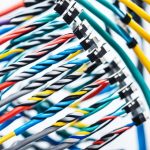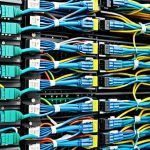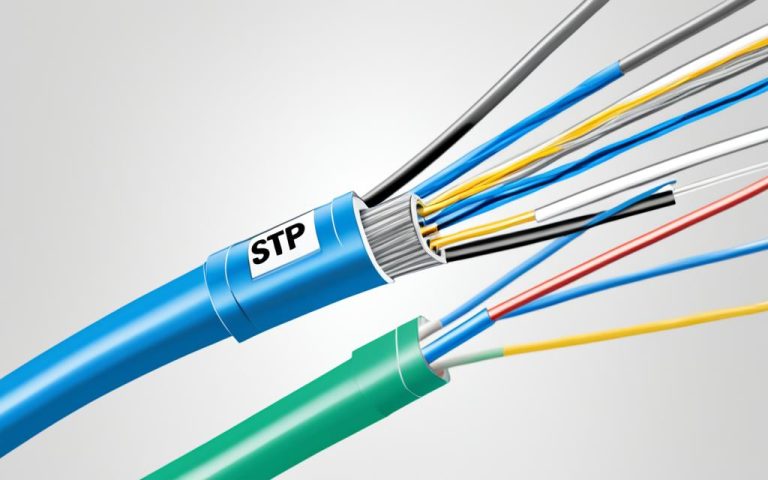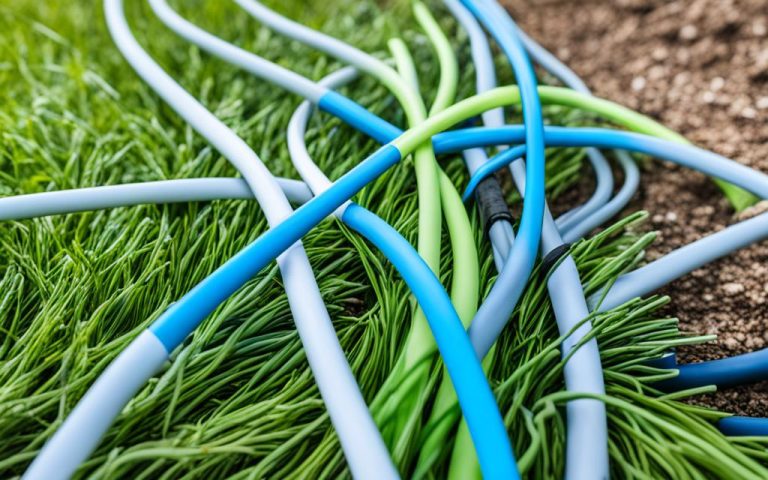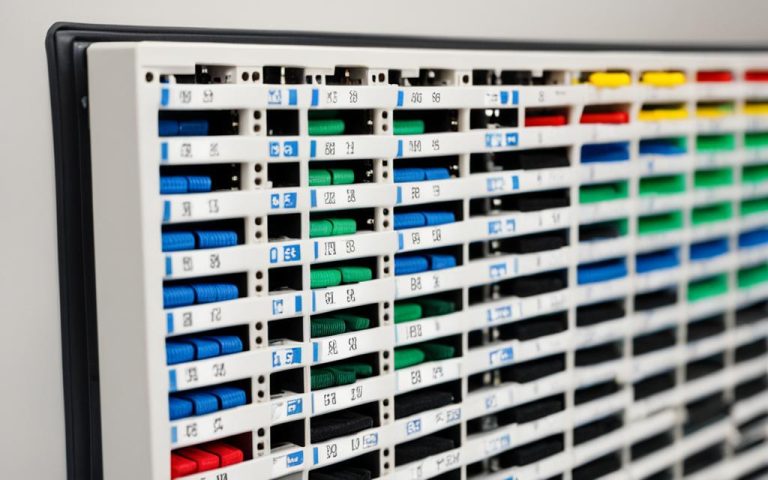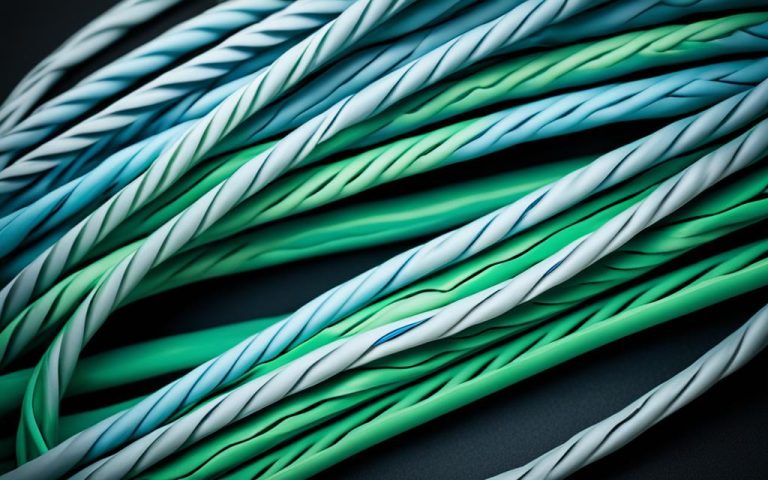Twisted pair cabling is a widely used communication medium in network infrastructure installations. It consists of one or more pairs of copper wires that are twisted together, offering a cost-effective solution for various applications. In this article, we will delve into the economics of twisted pair cable installations and explore their cost efficiency in modern networking infrastructures.
Twisted pair cables, known for their versatility, can carry both analog and digital data, making them suitable for voice and data transmission. They are relatively easy to install and terminate, reducing installation time and costs in network setups. Additionally, twisted pair cables have low susceptibility to interference, making them less vulnerable to electrical interference from nearby equipment or wires.
In the following sections, we will discuss the different types of twisted pair cables, their advantages and disadvantages, applications, classification, characteristics, and the challenges and prospects they bring to network installations. By understanding the cost-effectiveness and factors associated with twisted pair cabling, organizations can make informed decisions when implementing their networking infrastructures.
Understanding Twisted Pair Cable Types
When it comes to twisted pair cables, there are two main types: unshielded twisted pair (UTP) and shielded twisted pair (STP). Each type has its own distinct features and applications.
Unshielded Twisted Pair (UTP)
UTP cables are widely used in various networking installations. They consist of color-coded copper wires that are twisted together, providing a reliable and cost-effective transmission solution. One of the key advantages of UTP cables is their simplicity and ease of installation. They do not have any additional insulation or shielding, making them flexible and space-efficient. UTP cables are commonly used for short-distance transmissions of voice and data, making them ideal for applications such as local area networks (LANs), telephone lines, and Ethernet connections.
Shielded Twisted Pair (STP)
STP cables, on the other hand, offer enhanced protection against electromagnetic interference (EMI) due to their shielding design. The pairs of copper wires are not only twisted together but also covered with a foil or braided mesh, providing a layer of insulation. This shielding prevents external electromagnetic signals from interfering with the transmitted data, improving signal quality and reliability. STP cables are commonly used in environments with higher levels of EMI, such as industrial settings or areas with a high concentration of electronic equipment. However, it’s worth noting that STP cables are generally more expensive than UTP cables and require special connectors for installation.
https://www.youtube.com/watch?v=4-D2W8vKYvc
Understanding the different types of twisted pair cables is essential when designing and implementing network infrastructures. It allows organizations to choose the most appropriate cable type based on their specific requirements and the potential challenges they may face in terms of interference and signal quality.
Advantages of Twisted Pair Cable Installations
Twisted pair cable installations offer several advantages that make them a preferred choice for short-distance transmission in both voice and data applications. These cost-effective cables provide numerous benefits for network infrastructure:
- Cost-Effective Transmission: Twisted pair cables are highly cost-effective, making them an economical solution for data and voice transmission over short distances. Organizations can achieve reliable network connectivity without incurring significant expenses.
- Easy Implementation and Termination: The simplicity of implementing and terminating twisted pair cables reduces both installation time and costs. This makes them an attractive option for businesses seeking efficient network setup.
- Low Susceptibility to Interference: Twisted pair cables exhibit low susceptibility to interference caused by nearby electrical equipment or wires. This characteristic enhances signal quality and ensures consistent and reliable transmission of data and voice signals.
- Versatility: Twisted pair cables can carry both analog and digital signals, making them versatile for various applications. Whether transmitting voice data or digital information, twisted pair cables provide a reliable communication medium.
- Network Reliability: One of the key advantages of twisted pair cable installations is their self-contained design. If a portion of a twisted pair cable is damaged, it does not affect the entire network, improving overall network reliability and reducing downtime.
The cost-efficiency, low susceptibility to interference, and versatility of twisted pair cables make them a popular choice for network infrastructure installations. These advantages contribute to reliable and efficient voice and data transmission in a wide range of applications, from small businesses to large enterprises.
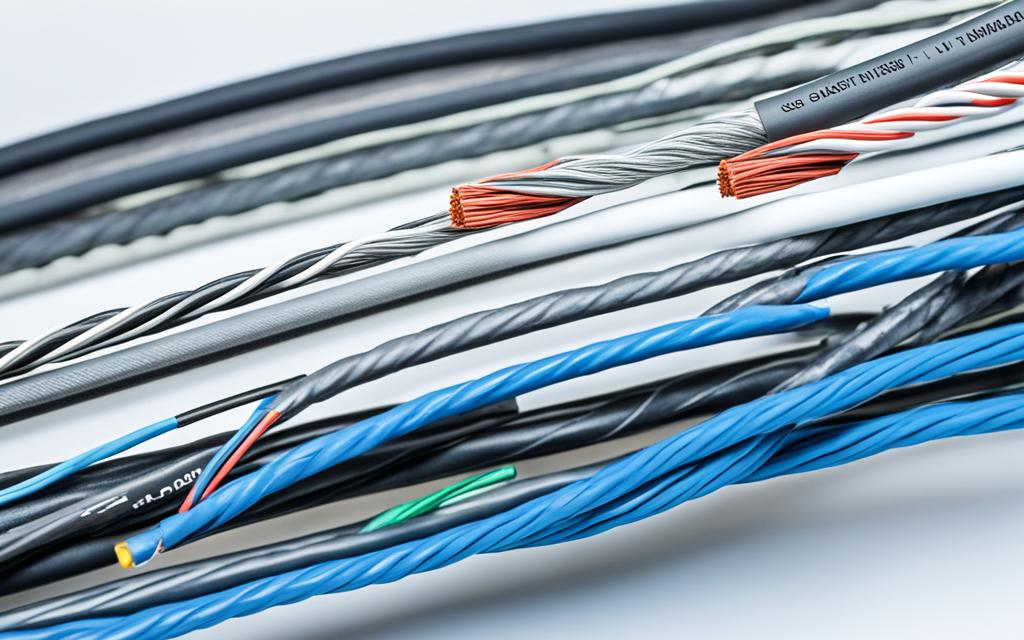
Advantages in Detail
| Advantage | Explanation |
|---|---|
| Cost-Effective Transmission | Twisted pair cables are a cost-effective solution for short-distance voice and data transmission, enabling organizations to achieve reliable network connectivity without incurring significant expenses. |
| Easy Implementation and Termination | The simplicity of implementing and terminating twisted pair cables reduces installation time and costs. This makes them an attractive option for businesses seeking efficient network setup. |
| Low Susceptibility to Interference | Twisted pair cables exhibit low susceptibility to interference caused by nearby electrical equipment or wires, enhancing signal quality and ensuring reliable data and voice transmission. |
| Versatility | Twisted pair cables can carry both analog and digital signals, making them a versatile communication medium suitable for various applications. |
| Network Reliability | Twisted pair cables have a self-contained design, meaning that if a portion of the cable is damaged, it does not affect the entire network. This improves overall network reliability and reduces downtime. |
Disadvantages of Twisted Pair Cable Installations
Despite the numerous advantages of twisted pair cables, they do have some drawbacks that need to be considered in network installations. These disadvantages include signal distortion, high attenuation, poor security, and susceptibility to electromagnetic interference (EMI).
Signal Distortion
Twisted pair cables can experience signal distortion, particularly over longer distances. This distortion can be caused by factors such as electrical interference, crosstalk, and impedance mismatch. As the length of the cable increases, the signal quality may deteriorate, leading to data errors or loss. This limitation makes twisted pair cables less suitable for applications that require high-fidelity transmission.
High Attenuation
Another disadvantage of twisted pair cables is their high attenuation, which refers to the weakening of the signal strength as it travels along the cable. The longer the cable, the greater the attenuation, making it challenging to achieve long-distance, high-speed transmissions. This limitation restricts the maximum reach of a network using twisted pair cables, requiring additional infrastructure and signal amplification for extended distances.
Poor Security
Twisted pair cables provide relatively poor security compared to other types of cables. They can be easily tapped or intercepted, making them vulnerable to unauthorized access or data theft. This limitation makes twisted pair cables less suitable for applications that require enhanced security measures, such as sensitive data transmission or confidential communication.
“The disadvantages of twisted pair cables, including signal distortion, high attenuation, and poor security, underscore the need for careful consideration and planning when selecting communication mediums for different network installations.”
Susceptibility to Electromagnetic Interference (EMI)
Twisted pair cables are susceptible to electromagnetic interference (EMI) from external sources. EMI can arise from nearby electronic devices, power cables, or radio frequency signals, leading to signal degradation or disruption. This susceptibility to interference can impact the overall reliability and performance of the network, requiring additional measures to minimize EMI, such as proper grounding or shielding.
To summarize, the disadvantages of twisted pair cable installations include signal distortion, high attenuation, poor security, and susceptibility to electromagnetic interference. It is essential for network administrators and installers to be aware of these limitations and consider alternative cable options for applications that demand higher transmission quality, longer distances, enhanced security, or protection against EMI.
Applications of Twisted Pair Cables
Twisted pair cables have wide-ranging applications across various industries and sectors, offering reliable communication solutions. Their versatility in carrying both analog and digital signals makes them a popular choice for different purposes. Let’s explore some of the key applications of twisted pair cables:
Telephone Lines
Telephone lines heavily rely on twisted pair cables to provide efficient data and voice channels for telecommunications. These cables enable the transmission of clear voice signals and ensure reliable connectivity for telephone communication. Twisted pair cables play a vital role in maintaining uninterrupted communication between individuals and businesses.
DSL Lines
For high-speed internet connections, DSL (Digital Subscriber Line) lines utilize twisted pair cables. With their ability to transmit both voice and data signals, twisted pair cables support the delivery of high-bandwidth internet access. DSL lines make it possible for individuals and businesses to enjoy fast and reliable internet connections, enabling activities such as video streaming, online gaming, and data transfers.
Local Area Networks (LAN)
Local Area Networks (LANs) often rely on twisted pair cables for data transmission within a confined area, such as offices, schools, or homes. Twisted pair cables enable the establishment of robust and secure network connections, facilitating the exchange of data between computers, printers, servers, and other network devices. These cables provide a cost-effective solution for creating reliable LAN infrastructures.
Additionally, twisted pair cables find applications in various other areas where data and voice transmission are required. They are commonly used in security systems, audio-visual installations, and home automation networks. Through the utilization of RJ-45 connectors, twisted pair cables also play a crucial role in Ethernet connections, ensuring seamless connectivity for computer networks.
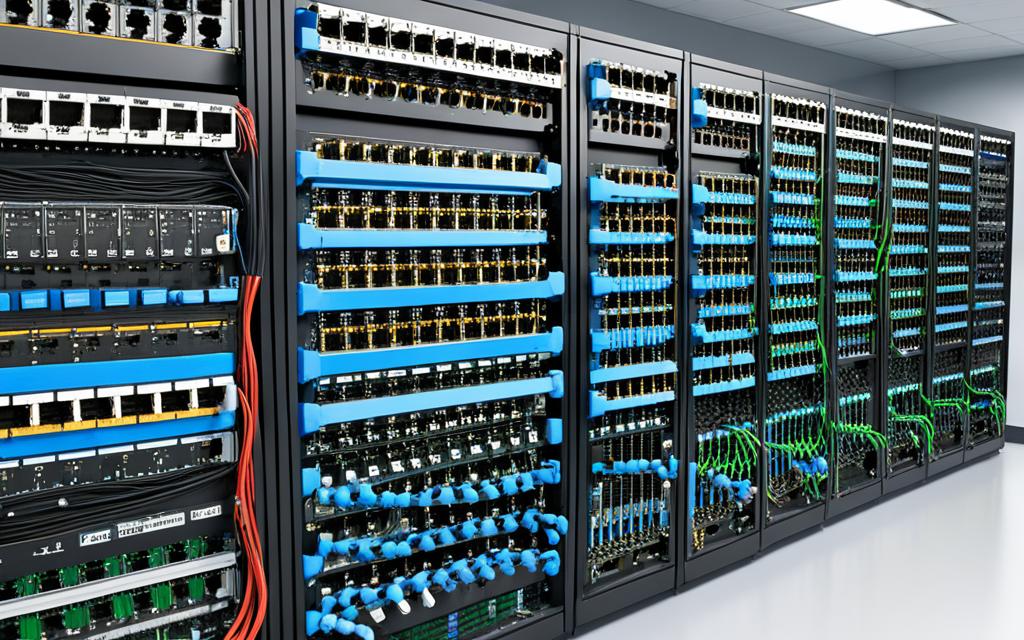
Twisted pair cables are a vital component in communication systems, offering cost-effective and reliable connectivity. Whether it’s for telephone lines, DSL connections, LANs, or other applications, these cables provide the backbone for efficient data and voice transmission.
Classification and Characteristics of Twisted Pair Cables
Twisted pair cables can be classified into different categories based on their characteristics. The most common classifications are based on whether the cable is shielded or unshielded. Unshielded twisted pair (UTP) cables do not have any additional insulation or shielding, while shielded twisted pair (STP) cables have a layer of shielding, usually made of foil or braided mesh.
The number of twisted pairs in a cable can vary, with some cables having multiple pairs for different signal transmission. Twisted pair cables have high transmission quality, long transmission distances, and strong anti-interference ability. They are also easy to use and have high reliability, making them a popular choice in various applications.
Twisted pair cables provide excellent transmission quality, ensuring reliable data and voice communication. They are capable of transmitting signals over long distances without significant loss in signal strength or quality. The twisted pair configuration minimizes crosstalk, reducing interference from adjacent pairs of wires.
UTP cables are widely used in home networks, small office setups, and telecommunication applications. They are cost-effective, easy to install, and offer satisfactory performance for most applications. On the other hand, STP cables are preferred in environments with high levels of electromagnetic interference, such as factories or areas with heavy machinery.
Twisted pair cables are suitable for both analog and digital signal transmission, offering versatility in various applications. They can be used in Ethernet connections, telephone lines, DSL lines, and local area networks (LANs). The ease of use, reliability, and compatibility with different devices make twisted pair cables a preferred choice in networking infrastructure installations.
Advantages of Twisted Pair Cables:
- Cost-effective solution for data and voice transmission
- Relatively easy to install and terminate
- Low susceptibility to interference
- Compatible with analog and digital transmission
Disadvantages of Twisted Pair Cables:
- Potential signal distortion over longer distances
- High attenuation limits maximum transmission distances
- Relatively poor security compared to other cable types
- Vulnerable to electromagnetic interference (EMI)
| Classification | Characteristics |
|---|---|
| Unshielded Twisted Pair (UTP) | No additional insulation or shielding |
| Shielded Twisted Pair (STP) | Layer of shielding, usually made of foil or braided mesh |
Twisted pair cables continue to be a reliable and cost-effective choice for numerous applications. While they have their limitations, ongoing advancements in cable technology offer prospects for improved performance and increased bandwidth capabilities. By understanding the classification and characteristics of twisted pair cables, organizations can select the appropriate type of cable for their specific networking needs.
Challenges and Prospects of Twisted Pair Cables
As twisted pair cables continue to be widely used, they face several challenges. One of the main challenges is the increasing demand for higher transmission speeds and bandwidth. Twisted pair cables have limitations in terms of maximum transmission rates and distance. As networking technology advances, there is a need for higher-performance cables to meet the growing demands of modern communication systems.
However, with advancements in cable manufacturing and design, there are prospects for the development of improved twisted pair cables that offer higher speeds and longer distances. Researchers and engineers are constantly working on enhancing the performance and capabilities of twisted pair cables to meet the evolving needs of the industry.
Realistic Challenges
- Inadequate transmission speeds and bandwidth
- Limitations in maximum transmission rates and distance
- Competition from other cable technologies
- Signal distortion and interference
“Twisted pair cables face challenges in meeting the increasing demands for higher transmission speeds and bandwidth.” – Expert in Networking Technology
Prospects for the Future
The prospects for twisted pair cables lie in the continuous research and development efforts to overcome their limitations. Some of the potential prospects include:
- Higher-performance twisted pair cables with improved transmission rates
- Longer-distance capabilities for extended network coverage
- Enhanced resistance to signal distortion and interference
These advancements would enable twisted pair cables to remain relevant and competitive in the face of increasing usage and evolving communication needs.
| Challenges | Prospects |
|---|---|
| Inadequate transmission speeds and bandwidth | Higher-performance twisted pair cables with improved transmission rates |
| Limitations in maximum transmission rates and distance | Longer-distance capabilities for extended network coverage |
| Competition from other cable technologies | Enhanced resistance to signal distortion and interference |
These realistic challenges and prospects demonstrate that twisted pair cables are not without limitations, but there is potential for growth and improvement. Organizations and professionals in the networking industry should closely monitor the advancements being made and consider the feasibility of incorporating the latest twisted pair cable technologies into their infrastructures.
Conclusion
The economics of twisted pair cabling in network installations are a key factor in ensuring cost-efficiency. Twisted pair cables offer a cost-effective solution for short-distance data and voice transmission, making them a popular choice in various applications. Their ease of installation and termination further contribute to their widespread use.
However, it is important to acknowledge the limitations of twisted pair cables. Signal distortion and high attenuation over longer distances can pose challenges to their performance. Despite these drawbacks, advancements in cable technology continue to offer prospects for improved capabilities and performance.
By thoroughly analyzing the cost-effectiveness of twisted pair cable installations and understanding their advantages and disadvantages, organizations can make informed decisions when implementing network infrastructures. It is crucial to consider factors such as signal quality, transmission distance, and the specific requirements of the application at hand to ensure optimal results.
In conclusion, the cost-effectiveness of twisted pair cabling is a significant consideration for network installations. While there are limitations to be aware of, the potential for improved performance coupled with their affordability make twisted pair cables a viable option for many organizations.
FAQ
What is twisted pair cabling?
Twisted pair cabling is a commonly used communication medium in networking infrastructure installations. It consists of one or more pairs of copper wires that are twisted together.
What are the two main types of twisted pair cables?
The two main types of twisted pair cables are unshielded twisted pair (UTP) and shielded twisted pair (STP).
What are the advantages of twisted pair cable installations?
Twisted pair cable installations are cost-effective, easy to implement and terminate, have low susceptibility to interference, and can carry both analog and digital signals.
What are the disadvantages of twisted pair cable installations?
Twisted pair cables can result in signal distortion, have high attenuation over longer distances, provide relatively poor security, and are susceptible to electromagnetic interference (EMI).
What are the applications of twisted pair cables?
Twisted pair cables are commonly used for telephone lines, DSL lines, local area networks (LANs), and Ethernet connections.
How are twisted pair cables classified?
Twisted pair cables can be classified based on whether they are shielded or unshielded, and the number of twisted pairs in a cable.
What are the challenges and prospects of twisted pair cables?
Twisted pair cables face challenges in meeting the demand for higher transmission speeds and bandwidth, but advancements in cable technology offer prospects for improved performance and capabilities.
What is the cost-efficiency of twisted pair cable installations?
Twisted pair cables offer a cost-effective solution for short-distance data and voice transmission, but it is important to consider their limitations and analyze their advantages and disadvantages when implementing networking infrastructures.

